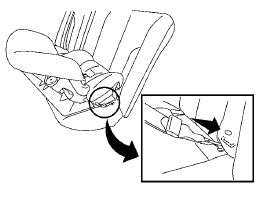Rear-facing child restraint installation using LATCH
Refer to all Warnings and Cautions in the “Child Safety” and “Child Restraint” sections before installing a child restraint.
Follow these steps to install a rear-facing child restraint in the 2nd row seats using the LATCH system:
1. Position the child restraint on the seat. Always follow the child restraint manufacturer’s instructions.

Rear-facing web-mounted – step 2
2. Secure the child restraint anchor attachments to the LATCH lower anchors. Check to make sure the LATCH attachment is properly attached to the lower anchors.

Rear-facing rigid-mounted – step 2

Rear-facing – step 3
3. For child restraints that are equipped with webbing-mounted attachments, remove any additional slack from the anchor attachments.
Press downward and rearward firmly in the center of the child restraint with your hand to compress the vehicle seat cushion and seatback while tightening the webbing of the anchor attachments.

Rear-facing – step 4
4. After attaching the child restraint, test it before
you place the child in it. Push it from side
to side while holding the child restraint near
the LATCH attachment path. The child restraint
should not move more than 1 inch
(25 mm), from side to side. Try to tug it
forward and check to see if the LATCH attachment
holds the restraint in place. If the
restraint is not secure, tighten the LATCH
attachment as necessary, or put the restraint
in another seat and test it again. You may
need to try a different child restraint or try
installing by using the vehicle seat belt (if
applicable). Not all child restraints fit in all
types of vehicles.
5. Check to make sure the child restraint is
properly secured prior to each use. If the
child restraint is loose, repeat steps 2
through 4.

See also:
Towing a trailer (Hardtop models)
WARNING
Overloading or improper loading of a
trailer and its cargo can adversely affect
vehicle handling, braking and performance
and may lead to accidents.
CAUTION
• Do not tow a trailer or h ...
Vehicle Identification Number (VIN) plate
The vehicle identification number plate is attached
as shown. This number is the identification
for your vehicle and is used in the vehicle
registration. ...
Front seats
Manual seat adjustment
Forward and backward:
Pull the lever1 up and hold it while you slide
the seat forward or backward to the desired
position. Release the lever to lock the seat in
position. ...
